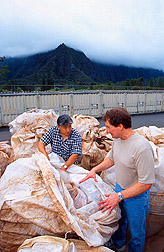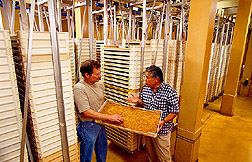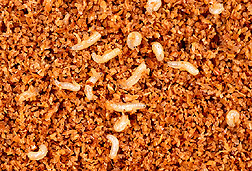Medfly Leftovers=Gourmet Feed
|
|
 ARS entomologist Eric Jang (left) and Stuart Stein, director of the USDA-APHIS Hawaii Fruit Fly Rearing Facility, examine a spent larval diet before shipping it to livestock yards where it will be fed to cattle. (K8756-1) |
Nutrients left over from mass-rearing of Mediterranean fruit flies make a good feed for livestock, according to ARSand university researchers in Hawaii. Their investigations could help convert a costly environmental problem into a new supplement for cattle or other animals. To fight outbreaks of the Mediterranean fruit fly, or medfly, states like California and Florida rely on shipments of millions of sexually sterile medflies reared in laboratories. A medfly factory run by USDA's Animal and Plant Health Inspection Service (APHIS) in Waimanalo, Hawaii, for example, supplies some 300 million sterile medflies every week for medfly control in the Los Angeles basin. When these sterile males mate with wild medfly females, no viable offspring result—and the population dies out. For part of the time when the medflies are growing at the mass-rearing facility, they eat a nutritious mixture of water, milled wheat bran or milled corn cobs, wheat germ, sugar, and yeast. The diet is caramel-to-brown in color and looks something like moist sawdust or dried oatmeal. |
|
 Stuart Stein (left) and Eric Jang inspect a larval diet for medflies. (K8755-1) |
Once the mix is no longer needed to nourish the insects, APHIS pays about $100,000 a year to dispose of the used or "spent" medfly diet. The Waimanalo plant generates about 12,000 pounds of this material every day. Getting rid of it is an environmental and economic problem, according to Waimanalo director Stuart H. Stein. Now, ARS scientists and their University of Hawaii colleagues have shown that spent diet can be used as livestock feed. The researchers determined the amount of protein, fat, carbohydrate, minerals, and other nutrients in spent diet from the APHIS facility and two other rearing labs in the state. Their tests with cattle and sheep showed that it is safe to eat and highly digestible. Harvey T. Chan, now retired from ARS, and Eric B. Jang of the ARS U.S. Pacific Basin Agricultural Research Center in Hilo, collaborated in the research with James R. Carpenter, Ruth Y. Niino-DuPonte, Harry M. Ako, and Halina A. Zaleski of the University of Hawaii College of Tropical Agriculture and Human Resources. |
|
 Medfly larvae consuming a highly nutritious corn-based diet. (K8758-1) |
The idea of recycling medfly diet isn't new. University scientists, for example, fed it to pigs for a study in the 1980s. In addition, some foreign labs that rear medflies already recycle their leftovers as feed. But the new studies are apparently the first to provide the data needed for a commercial trial with cattle in Hawaii. The North Shore Cattle Company on the island of Oahu now has an agreement with the Waimanalo factory to receive all of the used diet that it can provide, according to Stein. University scientists will monitor the effect of the new rations on the cattle weight gains that are essential for a profitable herd. Spent diet has the potential to replace 10 to 15 percent of the feed that Hawaii's livestock producers buy from other states as a supplement for their animals.—By Marcia Wood, Agricultural Research Service Information Staff. This research is part of Crop Protection and Quarantine, an ARS National Program (#304) described on the World Wide Web at http://www.nps.ars.usda.gov/programs/cppvs.htm. Eric B. Jang is with the USDA-ARS U.S. Pacific Basin Agricultural Research Center, Stainback Hwy., P.O. Box 4459, Hilo, HI 96720; phone (808) 959-4300, fax (808) 959-4323. |
|
"Medfly Leftovers=Gourmet Feed" was published in the March 2000 issue of Agricultural Research magazine.
|
|






